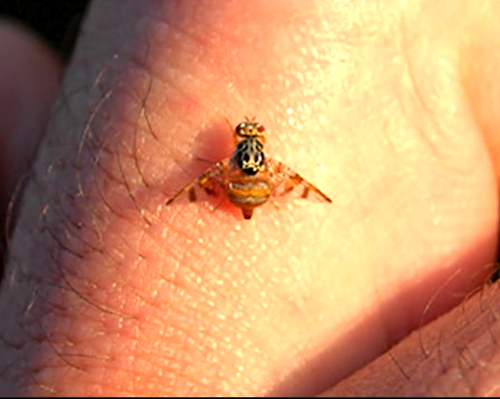|
|
Developmental Biology - Extending Life
Making Fruit Flies - Humans (?) Live Longer
Research identifies why reducing your food intake lengthens your life...
Reduced food intake, known as dietary restriction, leads to a longer lifespan in many animals and can improve health in humans as well. But, the molecular mechanisms behind this positive effect of dietary restriction are still unclear.
Researchers from the Max Planck Institute for Biology of Ageing have now found one possible explanation. By following the life cycle of fruit flies, they have identified a protein (Sestrin) that brings about the beneficial effects of dietary restriction. By increasing the amount of Sestrin in flies, researchers were able to extend fly lifespan and at the same time protect them against the lifespan-shortening effects of a protein-rich diet.
Research further showed that Sestrin plays a key role in stem cells in the fly gut thereby improving the health of the fly. Their work is published in Nature Aging.
The health benefits of dietary restriction have long been known. Recently, it's become clear that restricting certain food components, especially proteins and their individual building blocks - the amino acids, is more important for an organism's response to dietary restriction than calorie reduction. On the molecular level, the signalling pathway named TOR pathway, is important for longevity.
"We wanted to know which factor is responsible for measuring nutrients in the cell, especially amino acids, and how this factor affects the TOR pathway. We focused on a protein called Sestrin, which was suggested to sense amino acids. However, no one has ever demonstrated amino acid sensing function of Sestrin in a living being," explains Jiongming Lu, researcher in the department of Linda Partridge at the Max Planck Institute for Biology of Ageing.
Lu and colleagues focused on the role of Sestrin in the model organism Drosophila melanogaster, commonly known as the "fruit fly".
Sestrin as a Potential Anti-Ageing Factor
According to Linda Partridge, head of the research team: "Our results in flies revealed Sestrin as a novel potential anti-ageing factor. We could show that the Sestrin protein binds certain amino acids. When we inhibited this binding, the TOR signalling pathway in the flies was less active and the flies lived longer", adds Lu. "Flies with a mutated Sestrin protein unable to bind amino acids showed improved health in the presence of a protein-rich diet."
"When researchers increased the amount of Sestrin protein in stem cells located in the fly gut, these flies lived about ten percent longer than control flies. In addition, increasing Sestrin amounts only in gut stem cells also protected against the negative effect of a protein-rich diet.
We are curious whether the function of Sestrin in humans is similar as in flies. Experiments with mice already showed that Sestrin is required for the beneficial effects of exercise on the health of the animal. A drug that increases the activity of the Sestrin protein might therefore be in future a novel approach to slow down the ageing process."
Jiongming Lu PhD, Post doctural fellow, Partridge Laboratory, Max Planck Institute for Biology of Ageing, Cologne, Germany.
Abstract
Dietary restriction (DR) promotes healthy aging in diverse species. Essential amino acids play a key role, but the molecular mechanisms are unknown. The evolutionarily conserved Sestrin protein, an inhibitor of activity of the target of rapamycin complex 1 (TORC1), has recently been discovered as a sensor of amino acids in vitro. Here, we show that Sestrin null mutant flies have a blunted response of lifespan to DR. A mutant Sestrin fly line, with blocked amino acid binding and TORC1 activation, showed delayed development, reduced fecundity, extended lifespan and protection against lifespan-shortening, high-protein diets. Sestrin mediated reduced intestinal stem cell activity and gut cell turnover from DR, and stem cell proliferation in response to dietary amino acids, by regulating the TOR pathway and autophagy. Sestrin expression in intestinal stem cells was sufficient to maintain gut homeostasis and extend lifespan. Sestrin is thus a molecular link between dietary amino acids, stem cell function and longevity.
Authors
Jiongming Lu, Ulrike Temp, Andrea Müller-Hartmann, Jacqueline Esser, Sebastian Grönke and Linda Partridge.
Acknowledgements
The authors thank J. H. Lee, B. Edgar, G. Juhasz, the Bloomington Stock Center and the VDRC Stock Center for fly strains and reagents. We are also grateful to all members of the Partridge Lab for helpful insights, and to C. Demetriades for critical comments. Imaging was performed in the FACS and Imaging Core Facility, and amino acid concentrations were determined in the Metabolomics Core Facility at the Max Planck Institute for Biology of Ageing. The work was supported by a Swiss National Science Foundation (SNSF) postdoc fellowship (P2BEP3_162093) to J.L. and by funding from the Max Planck Society to L.P. The research leading to these results has received funding from the European Research Council under the European Union’s Seventh Framework Programme (FP7/2007-2013)/ERC grant agreement no. 268739.
Return to top of page.
| |
|
Nov 30 2020 Fetal Timeline Maternal Timeline News
 When researchers increased the amount of Sestrin protein in stem cells located in the fruit fly gut, flies lived about 10% longer than normal Mice also show that Sestrin i reqired for exercise to have beneficial affect on animal health. CREDIT Public Domain.
|



